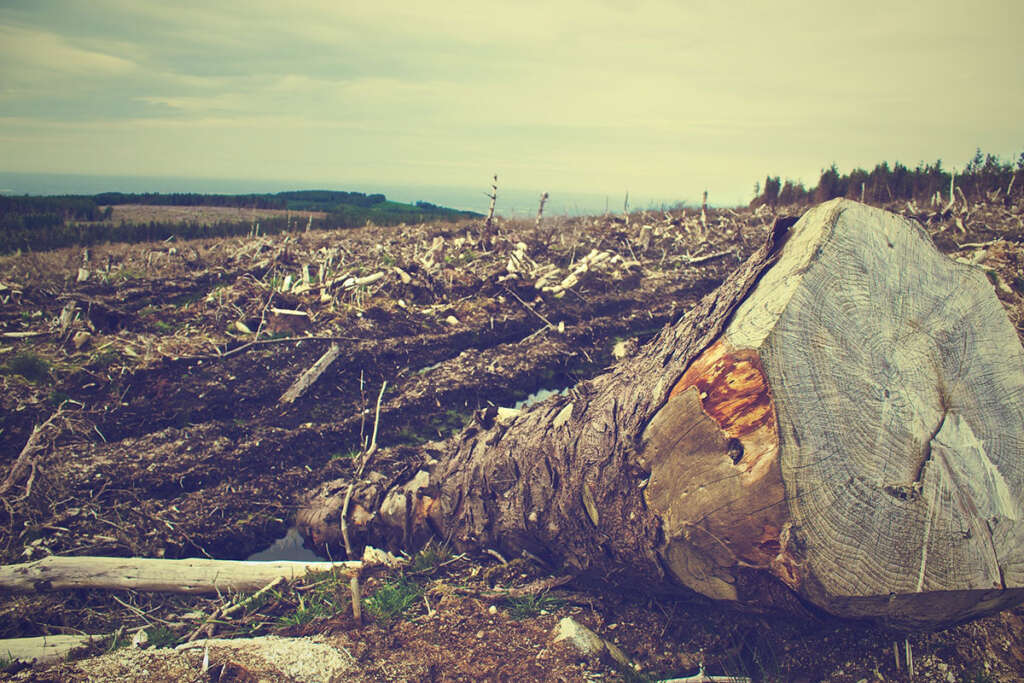Human activity has erased the third of all forests in the world in the last 10,000 years, which is the area of about two full United States. And half of that happened in the 20th century. How does this massive deforestation affect the environment, why do we still destroy forests and what role does meat consumption have?
The effects
In short, the consequences include severe losses in biodiversity, habitat of indigenous people, thousands of animal species, natural water filtration, flood prevention and soil degradation. And of course, it makes climate change worse as less trees can remove less carbon from the atmosphere while many of the killed trees are simply burnt which pumps more CO2 into the air.
By today, more than 18 million acres of forest are lost annually. This is 27 soccer fields every minute. Deforestation’s share in global greenhouse gas emissions is 15%. To put it in context, aviation is at 2.5%.

Biodiversity
Deforestation leads to the loss of habitats for millions of species. Forests are home to a myriad of plants, animals, and microorganisms. Clearing forests means many of them die, become endangered or even extinct. This also includes those that are undiscovered and can be keys to new medicines, foods, and ecosystem services. The fragmentation of habitats endangers species by isolating populations, reducing genetic diversity, and making it more difficult for species to adapt to environmental changes.
Indigenous people
For indigenous communities, forests are their home, integral to their culture, identity, and livelihoods. These communities are often deeply connected to their ancestral lands, relying on them for food, medicine, and materials. Imagine you grow up in the same neighbourhood (or village), have deep roots there and great connections with your local community spanning decades, you rely in every aspect on that community, and one day a corporation or the maffia, serving the corporation, completely tears it down, making you flee and you are lucky if they don’t kill you.
In many cases, deforestation displaces indigenous people, erode their culture, and mess up their traditional ways of life. You might think of Brazil as the prime example because it makes the news quite often but indigenous people (and environment, as a matter of fact) are not only affected by deforestation in South America but also in Africa and South-East Asia.
Natural water filtration
Forests play a very important role in natural filtration and regulation of water cycles. They help in purifying water by filtering pollutants and sediments as water moves through the forest floor. This process ensures the availability of clean water for drinking, agriculture, and sanitation. Deforestation damages or even destroys these natural filtration systems. The result? Increased water pollution and the degradation of freshwater resources. This not only affects human populations but also aquatic life that depends on clean water for survival.
Flood prevention
Forests act as natural sponges, absorbing rainfall and slowly releasing it into rivers and streams, reducing the risk of floods. When forests are cleared, the absence of vegetation means that there is less absorption of rainwater, leading to rapid runoff that can cause flooding downstream. This is obviously a risk for human life and property but it also leads to soil erosion, which degrades the land and reduces its fertility for agricultural use.
Soil degradation
And soil can be degraded by other means. The roots of forest trees bind soil together, preventing erosion. Trees also contribute to soil health by recycling nutrients through leaf litter. Without the protective canopy of a forest, the soil is directly exposed to sun and rain, which can lead to rapid degradation and loss of fertility. This makes it harder for vegetation to grow back. Without vegetation, landscapes become unsuitable for agriculture and natural ecosystems and if the degradation persist, they turn into deserts in the end.
CO2
Forests absorb CO2 from the atmosphere through photosynthesis. The burning and decomposition of trees release significant amounts of CO2, contributing to global warming. Less forests mean decreased capacity to absorb the ever increasing emissions. So on one side you got more and more CO2 emissions by deforestation, and on the other side you got less absorption. Double imbalance.
Why
Agriculture, mining and infrastructure, besides the obvious logging. They are the main reasons why forests are being destroyed. And of all those, agriculture is the real deal.
10,000 years ago 57% of the world’s habitable land was covered by forest. Today, it’s about 31% and still declining. We all know Amazon is the world’s most precious rainforest today. Greed and stupidity destroyed 20% of it in the past 50 years.
Meat
To satisfy the extreme demand of the world’s obscene meat fetish, agriculture needs a lot of land. As Brazil is the world’s biggest beef exporter, this means mostly cattle ranching in the Amazon: livestock is responsible for 70% of deforestation there. Many times, they don’t even bother to get rid of the trees in a little more useful way, such as selling them to make furniture, they just burn the forest. And to feed even more cows, lots of lands are needed to grow soybean.

Contrary to the belief, soy production in the world is not booming because of vegetarians and vegans. Soy’s primary use case is feeding cattle. The world’s soy production is projected to reach 400 million metric tons which is about 65% increase since 2012. 80% of this soy is grown for animals. And even a fraction of the remaining 20% is used in products for vegans and vegetarians.
So not only does beef production require a tremendous amount of land for pasture, but it also needs additional territory for soybean cultivation to feed more cattle.
Palm oil
But not only cattle causes deforestation. Palm oil, the cheap and unhealthy ingredient of most of junk food is a major player on the other side of the planet. Indonesia and Malaysia account for about 85% of global palm oil production, where forests are converted into palm oil plantations. This endangers species such as the Orangutan.
Perhaps you remember the huge fires in Indonesia a couple of years ago. Those fires destroyed forests and animals, pumped CO2 and toxic haze into the air. It’s actually the traditional way small scale farmers have been practicing for generations in order to clear their lands for new crops. But big corporations do this in extreme large scale and often for palm oil. In 2015, when 2.5 million hectares burned, the damage was $16 billion dollars. How on earth are we still using palm oil in almost everything?
Illegal logging
In Africa, the Congo Basin’s forests are also disappearing, mostly due to illegal logging. This region is the second biggest rainforest in the world after the Amazon. Illegal logging is valued between $51 to $152 billion annually (worldwide), and goes hand in hand with corruption, allowing criminal networks to profit at the expense of the environment and society.
Mining
Mining has significant environmental footprint, especially in forest-rich areas. Gold, copper, diamonds, and bauxite mines usually remove the forest cover to access the minerals below. This includes not only the extraction sites themselves but also the infrastructure needed for mining: roads, processing facilities, worker accommodations. Large-scale mining operations hit regions like the Amazon, Congo Basin, and Indonesia real hard.
On top of deforestation, mining often causes significant water pollution and degradation of surrounding lands due to the release of toxic substances. Soil erosion and the formation of tailing ponds can further harm local environments, making them unsuitable for forest regeneration.
Wrapping up
The main factors that are responsible for the destruction of forests are meat, palm oil, illegal logging and mining. They lead to astronomical losses in biodiversity, and damages to indigenous and local people, animals, water filtration, flood prevention, and soil. Additionally, deforestation is one of the major contributors to climate change. You can start helping by eating less meat (especially beef from those regions), for example.
What is the single biggest cause of deforestation?
The largest driver is agriculture, accounting for around 80% of deforestation worldwide.
Can reforestation offset the damages?
It depends. Reforestation can help restore ecosystems but it cannot fully replace the biodiversity and complexity of original forests. It’s very important what’s even more important is to finally stop deforestation.
How does deforestation affect climate change?
Deforestation contributes to climate change by releasing carbon dioxide stored in trees into the atmosphere, and by reducing the number of trees available to absorb existing CO2.
What can I do to help combat deforestation?
You can help by buying sustainable products, reducing meat consumption, and even supporting organizations that work to protect forests.
Sources
- WWF
- Union of Concerned Scientists
- FAO
- Global Forest Atlas
- World Bank
- Our World In Data
- USAID
Cover photo by DaveMeier


